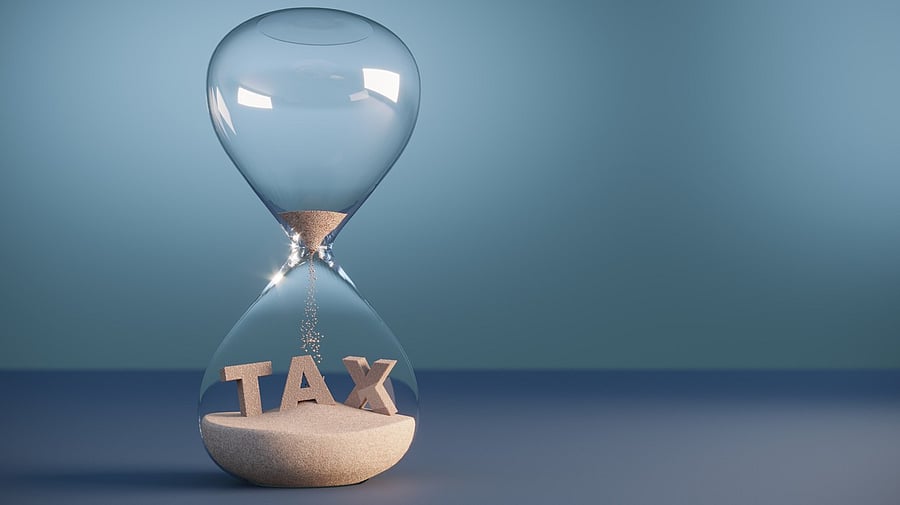
Representative image of tax.
Credit: iStock photo
The announcement by Union Finance Minister Nirmala Sitharman in Budget 2025-2026 to make incomes of up to Rs 12 lakh per annum tax free and incomes of up to Rs 24 lakh subject to lower tax rates for the assesses in the new tax regime has clearly caught the fancy of media, middle-class, and moneyed, as it promised a Rs 1 lakh-crore bonanza to them.
The Narendra Modi government has been pursuing the policy of hollowing-out income tax of its taxpayers since 2019. This new gift-away will certainly shrink the effective income-tax payee base to less than 2 crore Indians. Put into the context of India’s population, going forward less than 1.5 per cent of Indians will be paying income tax.
The Modi-led Bharatiya Janata Party (BJP) government abolished wealth tax in 2015. Is the income tax also on the way out?
India’s income-earners and taxpayers
The government survey, the Periodic Labour Force Survey (PLFS) 2023-2024, informs that India’s worker-population ratio (measure of how many all-age workers are in India as a proportion of total population) is 45.6 per cent.
For India’s estimated population of about 145 crore this ratio translates to 64 crore workers, which includes those self-employed in their businesses. About 22 per cent of total workers reportedly earned regular wage/salary, which makes India’s middle class about 15 crore-strong.
Government data published by the CBDT informs that there are 10.41 crore taxpayers — the persons who either filed a return of income tax (7.97 crore) and in whose case TDS was deducted- in the financial year 2022-2023.
Modi government hollowing-out income tax base
In the 2019-2020 Interim Budget, officiating finance minister Piyush Goyal announced full tax rebate to the taxpayers with taxable annual income of up to Rs 5 lakh and gleefully claimed that this measure would free ‘more than 3 crore salary earners and pensioners’ from the income-tax net.
He was right on the money. For FY 2020-2021, 3.47 crore returns were filed with total income of less than Rs 5 lakh. About 50 per cent of 6.37 crore taxpayers had become ‘income-tax mukt’ that year, reducing the number of actual taxpayers to about 2.8 crore. The process of hollowing-out the income-tax base of its taxpayers had begun.
On February 1, 2023, Sitharaman took another big step forward. She raised the no-income tax rebate on total income to Rs 7 lakh. As a result, as per CBDT data, 4.91 crore assesses out of the total 7.97 crore returns-filers in FY 2022-2023 paid no income tax, leaving only 3.08 crore actual income taxpayers.
The biggest blow has come on February 1, 2025. While announcing tax bonanza, Sitharman claimed that her proposal to raise the ‘no-income tax payment needed’ limit to Rs 12 lakh would provide Rs 1 lakh-crore relief to 1 crore tax-payers.
An analysis of the CBDT data reveals that of the 7.97 crore returns filed in 2022-2023, only 98.82 lakh taxpayers had returned income of more than Rs 10 lakh, (no break-up available for Rs 10-15 lakh range which had 43.04 lakh return-filers). Whatever assumptions one makes for growth of returns-filing assessees with more than Rs 12 lakh income in FY 2025-2026, it is unlikely that the number would exceed 1.5 crore.
Thus, the Modi government has successfully hollowed out India’s income tax system over the years by raising effective no-income tax limit in the last six years.
Tax slab reforms would have saved taxpayer base
The Modi government has not touched two crucial slab-tax limits in what is now termed the old income-tax regime — the tax exemption limit of Rs 2.5 lakh and the income slab of Rs 10 lakh at which the maximum tax rate of 30 per cent kicks in-ever since the BJP came to power in 2014.
A new/alternate tax-slab regime was introduced in 2022-2023 raising minimum exemption limit to Rs 3 lakh, which has been raised to 4 lakh in Budget 2025-2026. The 30 per cent tax rate limit was raised to Rs 15 lakh in 2023-2024, and now to Rs 24 lakh.
The irony of taxpayers in the old regime being subjected to maximum 30 per cent tax at Rs 10 lakh, while incomes of up to Rs 12 lakh remain tax-exempt under the new regime is hardly lost. This policy choice is, however, deliberate and clearly intended to destroy the income tax-payers base.
The Modi government had the choice of making the tax slabs and rates decided for the new tax regime to apply to all taxpayers, and of not using the policy of ‘no income tax’ up to Rs 12 lakh.
If this was done, all tax payers filing returns with income over Rs 4 lakh would be paying some tax. Calculations suggest that under this policy, only about 30 per cent of tax filers would be out of the tax net, thus keeping the taxpayers base of more than 6 crore intact.
Income tax on the way out?
The Modi government abolished wealth tax in 2015. The policy of ‘no-income tax’ payment up to Rs 12 lakh by granting rebates over last six years will reduce the income taxpayer base to less than 1.5 crore Indians only.
If the government were to raise this limit further in the next instalment (say, in 2029), India’s taxpayer base will fall below one crore with much less than 1 per cent Indians paying income tax.
It will be as good as abolishing income tax for Indians.
(Subhash Chandra Garg is former Finance & Economic Affairs Secretary, and author of ‘The Ten Trillion Dream Dented’, Commentary on Budget 2024-25 and ‘We Also Make Policy’.)
Disclaimer: The views expressed above are the author's own. They do not necessarily reflect the views of DH.